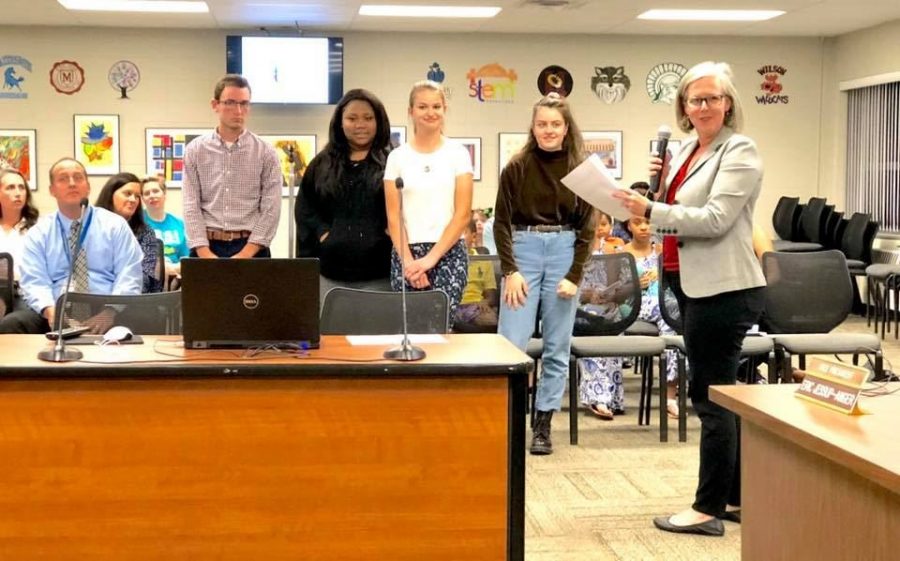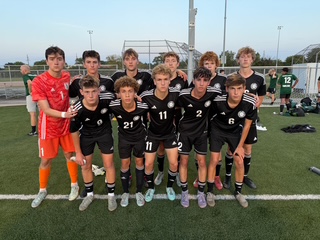Wauwatosa School District Students Join School Board as Student Representatives
January 9, 2019
Wauwatosa students from East and West High Schools began roles as student representatives on the district’s school board at the start of the 2018-2019 school year. The representatives attend meetings with the board acting as liasons between students and the board members.
In Wisconsin, there are 464 school districts. The State of Wisconsin requires each school district to elect a group of community members called a “school board”. School boards vote on policies proposed by the hired members of the school district. Policies can also be proposed by the school board.
The Wauwatosa School Board is made up of seven people. Each person is elected to a three year term. All members of the school board must be 18 years old and residents of Wauwatosa. They meet every other Monday in the Fisher building.
In some schools districts, though, students are also members of the school board. According to the Wisconsin Association of School Boards, 158 Wisconsin school districts have student representatives. Milwaukee County, Brown Deer, Greendale, Greenfield and West Allis are a few of the numerous cities with student representatives. Wauwatosa is now one of these school districts.
Student representatives are appointed or elected to their school board. In Brown Deer, the student representatives are recommended and chosen by the district administration. “Our board policy allows for up to two student representatives in any given year, but in reality we often only have one. We have also had student representatives serve on our two board committees (Finance & Facilities and Teaching & Learning)”, said Brown Deer School Board President, Kevin Klimek.
In Madison, Wisconsin, student representatives are elected to the position in a district wide election. Students must provide a platform, attend Student Senate and School Board meetings and be elected out of six different high schools. They serve for one calendar year and can be re-elected until they graduate.
In some states, the student representative does have voting rights. However, due to state statutes, this is not allowed in Wisconsin because they are typically not of age to vote. Instead, “the student representative…acts in an advisory role to the school board. They also act as a liaison between the school board and the students. Their function is to bring the ideas of the school board back to their schools,” said Dan Mallin, a member of the Legal and Policy Services Counsel for the Wisconsin Association of School Boards. Students aren’t allowed voting rights because it would dilute the vote of the elected board members, which would be unfair to the board members and the community members who voted for them. Thus, student representatives act more as a liaison between the board and the schools that they represent.
In a recent survey sent out to approximately 120 students and faculty, the vast majority of the 80 responses were for a student representative. The Wauwatosa School District Superintendent, Dr. Phil Ertl, thinks “it [student representatives to the school board] is a good idea as long as there is support of the School Board and the role is clearly defined.”
Rick Sear, a former student at West, explains, “In recent years, it has become clear that the school board makes a lot of decisions without input first from students and staff. It’s all well and good to listen to feedback after the fact, but it would be better to also alter plans befor they are implemented by listening to the opinions of those who will be most affected by them.”
An example of a decision made by the board without input from students is the Grading for Learning grading system. The system was brand new to everyone just under three years ago. Now and then, there are difficulties and loopholes with the system. Had the school board asked for input from the students, via a student representative, this grading system might not be in place.
Sometimes, even with the importance of student input, “board membership would not be appropriate,” said Brian Hoffman, a Tosa West Counselor. “The school board needs to handle extremely personal and confidential issues involving students and staff.” According to the school district policy, student representatives are encouraged to be present for all topics except, “sessions and items concerning specific personnel matters, employee performance, student discipline hearings, negotiations and grievances, tax levy, consideration of the sale or transfer of property and/or any other matter permitted to be discussed by the School Board in closed executive session under the Public Open Meeting Law.”
“Overall, I noticed a significant amount of more clarity on district policy amongst the student body compared to my experience in Wauwatosa,” says Michael Green, whose school district in Maryland had students on their school board. This proves that having students sit in on these discussions and voicing opinions on behalf of the student body really will improve the district.
The Wauwatosa School Board has voted unanimously in favor of student representatives and four students are now representatives. Sam Baierl and Nailah Boyd are from Wauwatosa West High School. Emma Gifford and Layne Donovan are from Wauwatosa East.
Emma Gifford said, “I wanted to serve as a student representative to the school board because I wanted to become more involved with local politics. I also have many ideas for changes in the schools that I hope to recommend to the board, but I also want to hear from all of the students to help make school better for them.”
Sam Baierl explains, “In order to join the school board I had to fill out a form that had various questions on why you want to be on the school board, why do you think you’d be a good fit, and then on top of that you had to get a signature from a student and get an evaluation from a student, a teacher and an administrator…That was sent off to the district and there was an interview process.”
Shawn Rolland, a member of the school board, hopes to see positive changes with this new policy. “Sometimes, as a student, you can feel like you’re powerless to affect change. It’s important to me that we’re giving you students-our future leaders- ways to raise your voices and shape your future,” he said.
Sam believes there will be changes. “They used student representatives a little bit last year, after the Parkland shooting incident. I think that’s what influenced the cell phone policy and the dress code policy. I think changes like that can just help create the daily life of going to school a little bit easier, a little bit more positive.”
“At the very least we know that students will know that they do indeed have a voice on the school board. Everyone feels better when they are well represented,” says Layne Donovan. “Our decisions can’t sway votes, but we can voice our opinions from the viewpoint of the students,” adds Sam Baierl.
Layne Donovan and Emma Gifford say their responsibilities as a representative include updating the board on what happens at their school and providing opinions and ideas for changes in the schools.
Each time they attend a meeting, they are given a topic to present on. The most recent topic that Sam Baierl and Nailah Boyd presented was on December 12, about creating connections that better represent students.
In order for school board members to be better informed, it is the responsibility of the student representatives to take news from the school to the board. Even though they won’t be able to vote, they can still advise the board members on certain issues and policies that will affect the schools. This can give the Wauwatosa School Board a wider range of knowledge about different issues and ensure that the student body will have their voice and opinion heard before policies are made. It is clear that students already feel better about some changes being made throughout the district.
Sam closed by saying, “Next year, both Nailah and I are seniors, so the position will be open for West, so I think it would be really cool if more people tried out for it. It’s a cool position.”













